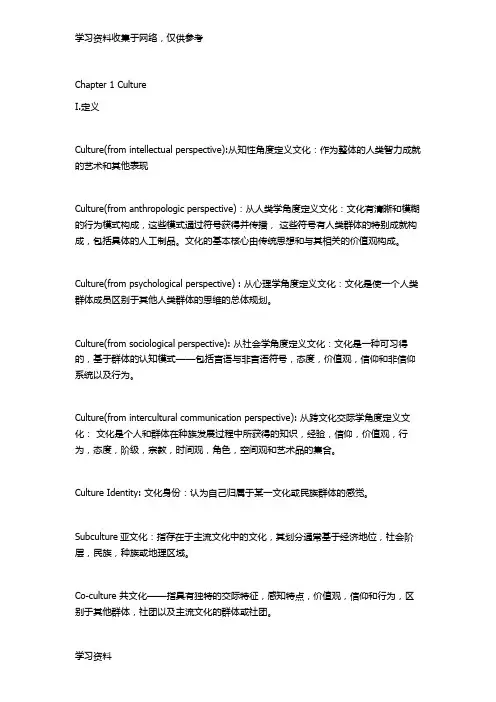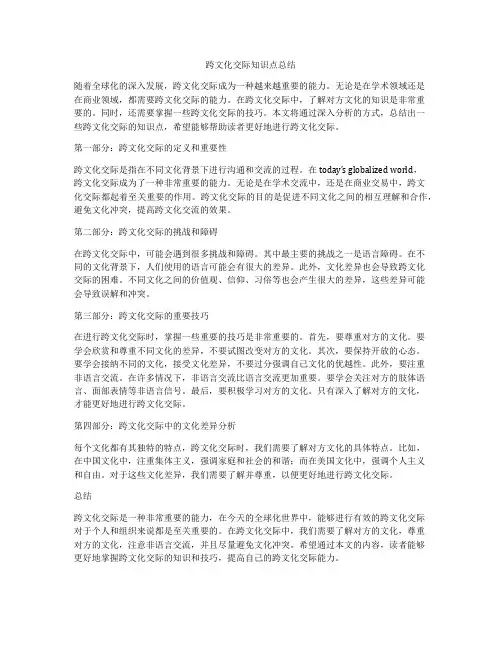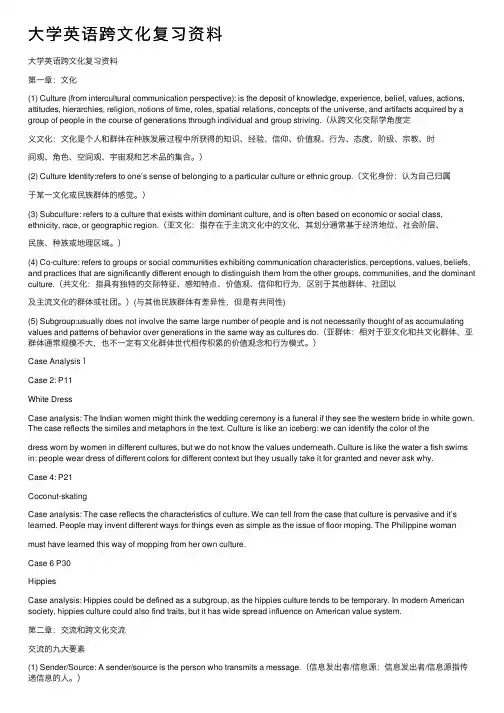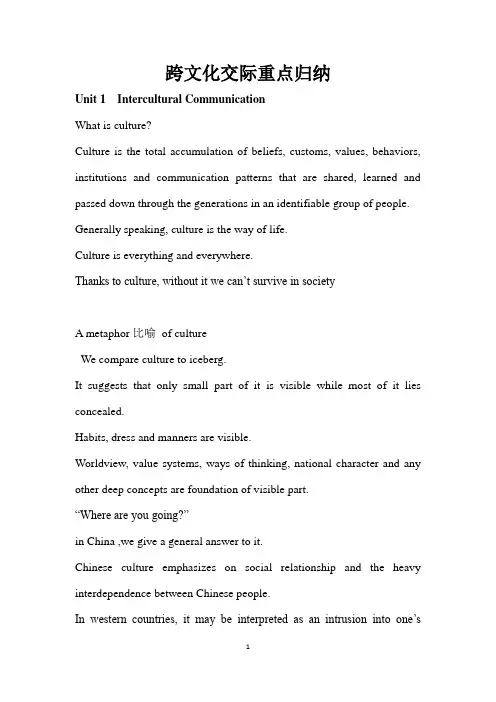大学英语跨文化交际要点汇总
大学英语跨文化复习重点

Chapter 1 CultureI.定义Culture(from intellectual perspective):从知性角度定义文化:作为整体的人类智力成就的艺术和其他表现Culture(from anthropologic perspective):从人类学角度定义文化:文化有清晰和模糊的行为模式构成,这些模式通过符号获得并传播,这些符号有人类群体的特别成就构成,包括具体的人工制品。
文化的基本核心由传统思想和与其相关的价值观构成。
Culture(from psychological perspective) : 从心理学角度定义文化:文化是使一个人类群体成员区别于其他人类群体的思维的总体规划。
Culture(from sociological perspective): 从社会学角度定义文化:文化是一种可习得的,基于群体的认知模式——包括言语与非言语符号,态度,价值观,信仰和非信仰系统以及行为。
Culture(from intercultural communication perspective): 从跨文化交际学角度定义文化:文化是个人和群体在种族发展过程中所获得的知识,经验,信仰,价值观,行为,态度,阶级,宗教,时间观,角色,空间观和艺术品的集合。
Culture Identity: 文化身份:认为自己归属于某一文化或民族群体的感觉。
Subculture亚文化:指存在于主流文化中的文化,其划分通常基于经济地位,社会阶层,民族,种族或地理区域。
Co-culture 共文化——指具有独特的交际特征,感知特点,价值观,信仰和行为,区别于其他群体,社团以及主流文化的群体或社团。
Subgroup 亚群体——相对于亚文化和共文化群体,亚群体通常规模不大,也不一定有文化群体时代相传积累的价值观念和行为模式。
Chapter 2 Communication and Intercultural Communication1. Sender/Source信息发出者/信息源:指传递信息的人2. Message信息:只引起信息接受者反应的任何信号。
跨文化交际重点梳理

重点1 Definition of cultureCulture is the total accumulation of beliefs, customs, values, institutions and munication patterns that are shared, learned and passed through the generations in an identifiable group of people.重点2 Characteristics of culture(10) 1、Culture is sharedCulture is a system of shared values beliefs or patterns of behaviors held in a group ,organization or society.It is not property of any individual.2、culture is cumulativeHuman beliefs, arts etc. are results of many generations.Every generations can discover the new things.The new knowledge are added to what was learned in previous generations.3、culture is learnedCulture is not inherent with any people.Culture can not be genetically and automatically passed down from previous generations.And it should be taught and learned by people.4、culture is adaptiveCulture is created by humans. Humans have to adapt the environment . thus is in development bears the trait of being adaptive5、culture is dynamicAt the same time that new culture are added, and the old ones are lost because they are no longer useful.6、culture is symbolicSymbols generally serve as municative tools for a multitude purposes, on a persons as well as culture level.7 、culture is relationalCulture is an organic whole. All the ponents of culture are interlinked.8 、culture is implicit and e*plicitSome layers culture are easy to be observe, like eating ,dressing, talking. But the ideas underlying the behaviors are generally hard to know. Many scholars label the culture as iceberg.9、 culture is universal10 、culture is diversified重点3 Hall,s dimensionsHigh conte*tHigh-conte*t munication relies heavily on nonverbal, conte*tual and shared cultural meanings.The meanings are not fully e*pressed.Meanings are determined by 〞 things are said , rather than 〞 is said.日本欧洲东部和南部阿拉伯CollectivismLow conte*tVerbal codes rather than the information impliesClear straight and to-the-point munication美国德国斯堪的纳维亚IndividualismMonochromic cultureDo one thing at one time, Concentrate on the job, take time seriously, low-conte*t and need information, mit to the job, religiously to the plans, not disturbing others, seldom borrow or lend things, emphasize promptnessPolychromic cultureDo many things at once, subject to interruptions, consider time mitments an objective to be achieved, high-conte*t and already have information. Change plans often. Emphasize the relationships.重点4 Triandis,s individualism & collectivismIndividualismFosters independence and individual achievement,Promotes self-e*pression ,personal choice, individual thinkingAssociated with egalitarian relationships and fle*ibility in rolesUnderstand the physical world as knowable apart of human lifeCollectivismInterdependence and group successPromotes adherence to normsAssociated with stable, hierarchical rolesShared property, group ownership重点5 Elements of municationSource (sender)EncodingMessageMedium(channel)ReceiverDecodingResponseFeedback重点6 Grice,s cooperative principle Quantity ma*imMake your contribute as informative as is required for the current purpose of e*change.Do not make your contribution more information than isrequired.〔量的准则——话语提供充分而不多余的信息〕Quality ma*imMake your contribution is ture〔质的准则——话语的容是真正的〕Relation ma*imBe relevant〔关系准则——话语与话题有关,即与所要实现的意图有关〕Manner ma*imBe perspicuousAvoid obscurity of e*pressionAvoid ambiguityDe brief and orderly(方式准则——说话要清晰明白、简洁而有条理)重点7 Brown & levinson’s face theoryFace is something that is emotionally invested, can be lost, maintained, or enhanced, and must be often attended to in municationPeople cooperate while maintaining face in interaction. Face theory : face threatening acts (FTAs)Politeness strategiesPoliteness 子威胁行为威胁行为strategies: bald on-record不使用补救措施赤裸裸的公开实行面off-record indirect strategy 非公开的实行面子negative politeness 消极礼貌策略Positive politeness 积极礼貌策略Face: negative facePositive face重点8 Thought patternsField dependence场依存性Holistic thinking eastern peoplePerspective of the whole, all the relevant parts take into account.Easily influence by othersField independence场独立性Analytic thinking western peopleDivinding the whole into parts to analyze the features or relations between the partsHardly influence by othersEastern: field-dependence, holistic thinking, high-conte*t Western: field-independence, analytic thinking, low-conte*t 重点9 Phases of negotiationPreparation 准备Non-task sounding 非任务测探Task-oriented e*changePersuasion 劝说ConcessionConclusion重点10 ponents of a brandBrand name 品牌名称〔产品〕Brand mark 品牌标志〔产品〕Trade name 商号〔公司名字〕Trade mark 品牌商标重点11 SWOT analysisStrengthsWeaknessesOpportunitiesThreats重点12 Intercultural advertising strategiesStandardization strategyConvey and e*tend the same advertising message to different markets and culturesKey point:Deal with the different markets using the same massageE*ample:MarlboroPhilips优点: reinforce the corporate imageSaving energyBe convenient to manage pared with several ads缺点: unlikely to be adaptive without change to all foreigncultureResult in misunderstanding or conflict even ruin a businessLocalization strategyStresses the specialties of the local market and adaptation to the local market environment重点13 Three meaning layers of adsthe surface meaningthe intended meaningthe cultural meaning。
跨文化交际知识点总结

跨文化交际知识点总结随着全球化的深入发展,跨文化交际成为一种越来越重要的能力。
无论是在学术领域还是在商业领域,都需要跨文化交际的能力。
在跨文化交际中,了解对方文化的知识是非常重要的。
同时,还需要掌握一些跨文化交际的技巧。
本文将通过深入分析的方式,总结出一些跨文化交际的知识点,希望能够帮助读者更好地进行跨文化交际。
第一部分:跨文化交际的定义和重要性跨文化交际是指在不同文化背景下进行沟通和交流的过程。
在today’s globalized world,跨文化交际成为了一种非常重要的能力。
无论是在学术交流中,还是在商业交易中,跨文化交际都起着至关重要的作用。
跨文化交际的目的是促进不同文化之间的相互理解和合作,避免文化冲突,提高跨文化交流的效果。
第二部分:跨文化交际的挑战和障碍在跨文化交际中,可能会遇到很多挑战和障碍。
其中最主要的挑战之一是语言障碍。
在不同的文化背景下,人们使用的语言可能会有很大的差异。
此外,文化差异也会导致跨文化交际的困难。
不同文化之间的价值观、信仰、习俗等也会产生很大的差异,这些差异可能会导致误解和冲突。
第三部分:跨文化交际的重要技巧在进行跨文化交际时,掌握一些重要的技巧是非常重要的。
首先,要尊重对方的文化。
要学会欣赏和尊重不同文化的差异,不要试图改变对方的文化。
其次,要保持开放的心态。
要学会接纳不同的文化,接受文化差异,不要过分强调自己文化的优越性。
此外,要注重非语言交流。
在许多情况下,非语言交流比语言交流更加重要。
要学会关注对方的肢体语言、面部表情等非语言信号。
最后,要积极学习对方的文化。
只有深入了解对方的文化,才能更好地进行跨文化交际。
第四部分:跨文化交际中的文化差异分析每个文化都有其独特的特点,跨文化交际时,我们需要了解对方文化的具体特点。
比如,在中国文化中,注重集体主义,强调家庭和社会的和谐;而在美国文化中,强调个人主义和自由。
对于这些文化差异,我们需要了解并尊重,以便更好地进行跨文化交际。
大学英语跨文化交际 要点汇总29页PPT

66、节制使快乐增加并使享受加强。 ——德 谟克利 特 67、今天应做的事没有做,明天再早也 是耽误 了。——裴斯 泰洛齐 68、决定一个人的一生,以及整个命运 的,只 是一瞬 之间。 ——歌 德 69、懒人无法享受休息之乐。——拉布 克 70、浪费时间是一桩大罪过。——卢梭
大学英语跨文化交际 要点汇总
•
6、、心急吃不了热汤圆。
•
8、你可以很有个性,但某些时候请收 敛。
•
9、只为成功找方法,不为失败找借口 (蹩脚 的工人 总是说 工具不 好)。
•
10、只要下定决心克服恐惧,便几乎 能克服 任何恐 惧。因 为,请 记住, 除了在 脑海中 ,恐惧 无处藏 身。-- 戴尔. 卡耐基 。
大学英语跨文化复习资料

⼤学英语跨⽂化复习资料⼤学英语跨⽂化复习资料第⼀章:⽂化(1) Culture (from intercultural communication perspective): is the deposit of knowledge, experience, belief, values, actions, attitudes, hierarchies, religion, notions of time, roles, spatial relations, concepts of the universe, and artifacts acquired by a group of people in the course of generations through individual and group striving.(从跨⽂化交际学⾓度定义⽂化:⽂化是个⼈和群体在种族发展过程中所获得的知识、经验、信仰、价值观、⾏为、态度、阶级、宗教、时间观、⾓⾊、空间观、宇宙观和艺术品的集合。
)(2) Culture Identity:refers to one’s sense of belonging to a particular culture or ethnic group.(⽂化⾝份:认为⾃⼰归属于某⼀⽂化或民族群体的感觉。
)(3) Subculture: refers to a culture that exists within dominant culture, and is often based on economic or social class, ethnicity, race, or geographic region.(亚⽂化:指存在于主流⽂化中的⽂化,其划分通常基于经济地位、社会阶层、民族、种族或地理区域。
)(4) Co-culture: refers to groups or social communities exhibiting communication characteristics, perceptions, values, beliefs, and practices that are significantly different enough to distinguish them from the other groups, communities, and the dominant culture.(共⽂化:指具有独特的交际特征、感知特点、价值观、信仰和⾏为,区别于其他群体、社团以及主流⽂化的群体或社团。
跨文化交际重点归纳

跨文化交际重点归纳Unit 1 Intercultural CommunicationWhat is culture?Culture is the total accumulation of beliefs, customs, values, behaviors, institutions and communication patterns that are shared, learned and passed down through the generations in an identifiable group of people. Generally speaking, culture is the way of life.Culture is everything and everywhere.Thanks to culture, without it we can’t survive in societyA metaphor比喻of cultureWe compare culture to iceberg.It suggests that only small part of it is visible while most of it lies concealed.Habits, dress and manners are visible.Worldview, value systems, ways of thinking, national character and any other deep concepts are foundation of visible part.“Where are you going?”in China ,we give a general answer to it.Chinese culture emphasizes on social relationship and the heavy interdependence between Chinese people.In western countries, it may be interpreted as an intrusion into one’sprivacy.The underlying individual-oriented relationship is the invisible part of the iceberg.exercise1. If you are a tourist guide, what are you expected to say when you are showing the foreign visitors to another site?A. This way, please.B. Come here, please.C. Follow me, please.D. Move on.2. A visitor stops you in the corridor of your head-office probably to ask for the way. What is your most likely reply to the visitor’s “Excuse me”?A. What’s the matter?B. Yes?C. That’s all right.D. Don’t worry.3. At a fair, a visitor, accidentally having knocked down your poster, says, “I’m terribly sorry.” What should you reply?A. It doesn’t matter.B. Never mind.C. Don’t worry.D. That’s all right.What is Intercultural communication?“Intercultural communication is contact between persons who identify themselves as distinct from one another in cultural terms.” (Collier & Thomas, 1998)intercultural communication refers to any communication between two members of any cultural communities. (Samovar & Porter)To further understand “intercultural communication”, please read the section of “Intercultural Communication Reading” on P.2 and answer the questions:1 In the story, why does Pete could not communicate well with Chinese students?Language problemCulture problemThe way Pete handled the intercultural communication situation2 What are the major barriers in intercultural communication? Language difference.(If we understand others’ language or dialect, but not their communication rules, we can made fluent fools of ourselves.) Nonverbal communication: gestures, postures, facial expression etc. Stereotypes: like culture, religion, idea, value, etc.Watch a video and get a deeper understanding.Classifications of Communicationverbal /nonverbalDirect /indirectInterpersonal / interorganizational / mass media-basedIntracultural /interculturalIntrapersonal / interpersonal/…Case studyRead the passage of “ an Intercultural Classroom”. This is the beginning of this passage:It was a hot day. Since it was still too early to use the air-conditioner, according to the regulations of the university, every class kept its door open to make the classroom cooler. While I was lecturing on Chinese grammar in Class 4, waves of laughter came from the neighboring Class 5. A German student named Stephen raised his hand and stood up. “The laughter from Class 5 is bothering us. I think we should go to their class to protest,” he said….1 How many different solutions did Class 4 propose?2 what is the mode of communication favored by Asians? What cultural values underlie it?Asian people are very courteous and indirect in their communications. They put great emphasis on group harmony, they are very tolerant, even when they are offended. These collectivistic values, shaped by Confusion teachings, were spread from China to many Asian countries.3 what is the mode of communication favored by Westerners? What cultural values underlie it?Westerners are generally very direct and frank in their mode ofcommunication. And they have a strong sense of protecting their own rights. Individualistic values are the underlying principles governing their behavior.Classroom activity 11. Read the story on P1 and answer: Why do you think the driver is asking for $50 instead of $32.5?2. Work in groups and write down 5 ways to deal with the situation. Some likely interpretationsThe taxi driver is trying to cheat Lee.extra charges for luggage that Lee doesn’t know about.Extra charges for tolls that Lee doesn’t know.There is an honest misunderstanding.L ee misunderstood what the driver said, or didn’t hear what he said clearly.The driver has included a tip for himself –an unreasonably large one. Culture NoteTaxi charges: in taxis in the us, it is quite normal to have a small extra charge for each of luggage. In the us there are also sometimes tolls for bridges, tunnels and certain roads. and the taxi driver will pay these first and then add them to the cost of the ride.Tipping: in the us it is normal to add a tip of 10%-15% to the cost of a taxi ride. (tipping is not normal in fast-food restaurants where customs gettheir own food.Taxis in the Us: while taxis can often be found at Us airports, taxis are rare in all but the largest American cities, and to get a taxi people often need to call a taxi company. This is because most Americans drive their cars. (in large cities, taxi drivers are often immigrants form other countries who do not speak English as their first language.)Classroom activity 2Read Letter to Fran: Not Eating and answer the following questions.1. Why did Nancy eat so little?2. Tell the possible reasons for Nancy’s problem.Possible reasonsOn the whole, American cooking tends to be somewhat more bland than the cooking in most parts of China.Some westerners have allergic reactions to MSG(often used in Chinese cooking) and get headaches if they eat food containing it.Some Christians won’t drink alcoholic beverages.Read Fran’s Response: Not Eating after class and get more information. Discuss the differences of table manners between Chinese and Westerners.Chinese people often use words like color 、smell 、taste、shape to describe the food.Westerners usually pay more attention to the calories、vitamins、proteinsand so on.we would invite many people “the more the better”If the host respect you ,he will give you a seat at first and sit on the left chair .The host will prepare all the things ready. The host will get delicious food into the guest’s bowl .Westerners would like to keep quiet. They regard the right as a symbol of respect.The host will let the guests choose what to eat or drink.Individualist and CollectivistWhat are the characteristics of Individualist and Collectivist? Classroom activity 3Read the passage Individualist and Collectivist Cultures and finish the following tasks.What are some differences between an individualist culture and a collectivist one?find out ways of how do Chinese show individualism and how do westerners show their collectivism. You may need to supply your points with examples.Assignment:Review unit 1 and Preview unit 2Work in teams of 6 and deliver a presentation on following topics:What are differences between an individualist culture and a collectivistone?find out ways of how do Chinese show individualism and how do westerners show their collectivism. You may need to supply your points with examples.Unit 2Review: Interpretation解释、翻译of greetings上哪去?Where are you going?It’s none of your business!去哪啦?Where have you been?吃过了吗?Have you had your meal?Are you going to invite me to dinner?Acceptable Greetings中文出去呀?吃饭去?回来了?忙着呢?忙什么呢?在洗车呀?这衣服真漂亮,新买的吧?你看起来气色不错。
跨文化交际英语知识点归纳
跨文化交际英语知识点归纳跨文化交际是指在不同文化背景下进行的人际交往和沟通。
在全球化背景下,跨文化交际的重要性日益凸显。
了解并掌握跨文化交际的英语知识点对于有效地与不同文化背景的人进行交流和合作至关重要。
本文将详细介绍跨文化交际的英语知识点,包括文化差异、非语言交际、礼仪与礼貌等方面。
一、文化差异1. 时间观念:不同文化有不同的时间观念,如西方注重准时,东方则注重灵活性。
了解并尊重对方的时间观念,避免引起误会。
2. 社会等级:不同文化中对社会地位的看法不同,有些文化注重等级分明,有些文化则强调平等。
在交际中应注意尊重对方的社会地位和身份。
3. 个人主义与集体主义:西方文化注重个利和自由,而东方文化注重集体利益和团队协作。
了解并尊重不同文化的价值观念,有助于建立良好的跨文化交际关系。
二、非语言交际1. 肢体语言:不同文化对于肢体语言的解读和使用有所差异,如眼神接触、手势等。
了解并注意对方的肢体语言,避免产生误解。
2. 面部表情:不同文化对面部表情的解读也有所差异,如微笑、皱眉等。
了解并适应对方的面部表情,有助于推动交际进程。
3. 身体姿势:身体姿势也是非语言交际的一种形式,如坐姿、站姿等。
注意对方的身体姿势,尊重对方的个人空间,避免给对方带来不适。
三、礼仪与礼貌1. 问候礼仪:不同文化有不同的问候方式和习惯,如握手、鞠躬等。
了解并尊重对方的问候方式,展示友好和尊重。
2. 礼貌用语:不同文化有不同的礼貌用语和礼貌表达方式,如道歉、感谢等。
适当使用对方的礼貌用语,展示尊重和关注。
3. 社交礼节:不同文化有不同的社交礼节,如用餐礼仪、着装规范等。
了解并遵守对方的社交礼节,展示自己的文化素养。
四、语言交际1. 语言障碍:不同文化使用不同的语言,语言障碍是跨文化交际中常见的问题。
尽量使用简洁明了的词汇和表达方式,避免产生歧义和误解。
2. 文化障碍:语言与文化密切相关,不同文化对于词汇、语法和表达方式有不同的理解和运用。
新编跨文化交际英语教程 复习总结
Unit 11.The definition of INTERCULTURAL COMMUNICATION1.1“Inter-" comes from the Latin word for "between",and dictionaries define communication as exchanging information.Inter-"来自拉丁语,意思是"在之间",字典把交流定义为交换信息。
Intercultural Communication refers to the exchange of information between people from different cultures.跨文化交际是指来自不同文化的人之间的信息交流。
As the very phrase suggests, Intercultural Communication emphasizes cross-cultural competence rather than language only.正如这句话所暗示的,跨文化交际强调的是跨文化能力,而不仅仅是语言。
1.2 what makes IC a common phenomenon: new technology, innovative communication system,globalization of the economy , changes in immigration patterns 新技术、创新的通讯系统、经济全球化、移民模式的变化2.The definition of globalizationGlobalization is the process by which regional economies, societies, and cultures have become integrated through communication, transportation,and trade between nations.全球化是区域经济、社会和文化通过国家之间的交流、运输和贸易而变得一体化的过程。
跨文化交际英语知识点归纳
跨文化交际英语知识点归纳1. 礼仪(Etiquette)礼仪是不同文化交往中最基本的要素之一。
在跨文化交际中,礼仪的重要性不言而喻。
例如,不同国家、不同文化的人在相互交往时,他们的相互礼仪的表达方式都是有所不同的。
2. 规范和价值观(Norms and Values)规范是一种文化内部形成的行为结构,是一种文化共同遵守的行为方式。
在跨文化交际中,了解对方所遵循的规范是非常重要的,这有助于避免在交流中出现不必要的误解和冲突。
3. 语言和文化(Language and Culture)语言是人类进行交流的最基本手段。
语言和文化是紧密相关的。
例如,美国英语和英国英语在用词和发音上有所不同,这也反映出两个国家的文化差异。
4. 非语言交际(Non-Verbal Communication)除了语言外,身体语言、肢体动作、面部表情、姿势等非语言交际也是跨文化交际中不可忽视的因素。
这些非语言交际动作在不同文化间也存在差异。
5. 社会组织形态和社会关系(Social Organization and Relationships)不同文化的社会组织形态和社会关系也是非常不同的。
例如,中国传统文化中注重家庭、亲情和社会关系,而西方文化则注重个性、自由和独立性。
6. 时间观念(Time)不同国家和文化对时间观念的重视程度也存在差异。
例如,在日本文化中,迟到被看作是不尊重别人的行为,而在西方文化中,稍微迟到几分钟不会被认为是什么大问题。
7. 社会礼仪和礼节(Social Etiquette and Formalities)在跨文化交际中,了解对方的社会礼仪和礼节也是非常重要的。
例如,上司和下属之间的交往在不同文化中有着不同的礼节和规范。
8. 语言表达方式和文化复杂性(Language Expression and Cultural Complexity)语言表达方式和文化的复杂性也是跨文化交际中重要的要素之一。
不同文化的语言表达方式有着不同的复杂度和难度,了解这些差异有助于更好地理解对方文化的复杂度。
新编跨文化交际英语教程知识点梳理
新编跨文化交际英语教程知识点梳理(实用版)目录1.新编跨文化交际英语教程的概念与目的2.跨文化交际的重要性3.新编跨文化交际英语教程的主要内容4.新编跨文化交际英语教程的特点与亮点5.新编跨文化交际英语教程的应用与实践正文一、新编跨文化交际英语教程的概念与目的新编跨文化交际英语教程是一本针对英语学习者的教材,旨在帮助学生更好地理解和应对跨文化交际中的各种问题。
该教程通过讲解文化、交际、语言以及跨文化交际等相关概念,使学生能够较为客观、系统、全面地认识英语国家的文化,从而提高跨文化交际能力。
二、跨文化交际的重要性随着全球化的不断深入,跨文化交际在我们的生活中扮演着越来越重要的角色。
对于英语学习者来说,掌握跨文化交际的能力不仅能够帮助他们更自信地与来自不同文化背景的人进行交流,还能够拓宽他们的国际视野,提高他们的综合素质。
三、新编跨文化交际英语教程的主要内容新编跨文化交际英语教程共分为 10 个单元,涵盖了全球化时代的交际问题、文化与交际、各类文化差异、语言与文化、跨文化言语交际、跨文化非言语交际、时间与空间使用上的文化、跨文化感知、跨文化适应、跨文化能力等各个方面。
每个单元都以阅读文章为主线,配有形式多样的练习和数量较多的案例分析,同时还提供丰富的相关文化背景知识材料,供选择使用,以满足不同的教学情境和需求。
四、新编跨文化交际英语教程的特点与亮点新编跨文化交际英语教程具有以下特点和亮点:1.实用性:教材选材广泛,包括了几十个实例,既有趣味性,又有实用性,能够帮助学生在实际交际中更好地运用所学知识。
2.系统性:教程对跨文化交际的各个方面进行了全面、深入的讲解,使学生能够系统地掌握跨文化交际的知识和技能。
3.灵活性:教材形式多样,既有阅读文章,又有练习和案例分析,能够满足不同学生的学习需求和教学情境。
4.丰富性:教材提供了丰富的相关文化背景知识材料,帮助学生更好地理解和感知英语国家的文化。
五、新编跨文化交际英语教程的应用与实践新编跨文化交际英语教程在实际应用中,可以通过以下方式进行实践:1.在课堂教学中,教师可以结合教材的内容,进行跨文化交际的讲解和训练,帮助学生提高跨文化交际能力。
- 1、下载文档前请自行甄别文档内容的完整性,平台不提供额外的编辑、内容补充、找答案等附加服务。
- 2、"仅部分预览"的文档,不可在线预览部分如存在完整性等问题,可反馈申请退款(可完整预览的文档不适用该条件!)。
- 3、如文档侵犯您的权益,请联系客服反馈,我们会尽快为您处理(人工客服工作时间:9:00-18:30)。
Culture is dynamic. (pg. 6)
◦ Acculturation(文化适应): the process which adopts the changes brought about by another culture and develops an increased similarity between the two cultures.
Noise ◦ The term noise technically refers to anythingthat distorts the message the source encodes.
Components of Communication
Source ◦ The source is the person with an idea he or she desires to communicate.
Encoding ◦ Encodingis the process of puttingan idea into a symbol.
Characteristics of Culture
Culture is shared.
Culture is learned.
◦ Enculturation(文化习得) : all the activities of learning one’s culture are called enculturation.
(what they think)
How to understand Cultural Iceberg
The plicit, visible, taught.
The aspects of culture that are intangible and not taught directly.
Global village: All the different parts of the world form one community linked together by electronic communications, especially the Internet.
Meltingpot: a socio-cultural assimilation of people of different backgrounds and nationalities.
What are the three ingredients of culture?
1. Artifacts (the material and spiritual products people produce)
2. behavior (what they do) 3. concepts (beliefs, values, world views…)
Culture is ethnocentric(文化中心主义).
◦ Ethnocentrism: the belief that your own cultural background is superior.
Communication
Communication: meaning to share with or to make common, as in giving to another a part or share of your thoughts, hopes, and knowledge.
Cultural Diversity: the mix of people from various backgrounds in the labor force with a full mix of cultures and sub-cultures to which members belong.
Message ◦ The term message identifies the encoded thought. Encoding is the process, the verb; the message is the resulting object.
Channel ◦ The term channel is used technically to refer to the means by which the encodedmessage is transmitted. The channel or medium, then, may be print, electronic, or the light and sound waves of the face-to-face communication.
Unit 1
Economicglobalization: the integration of national economies into the international economy through trade, foreign direct investment, capital flows, migration, and the spread of technology.
The concept of culture
Culture: a learned set of shared interpretations about beliefs, values, and norms, which affect the behavior of a relatively large group of people.
